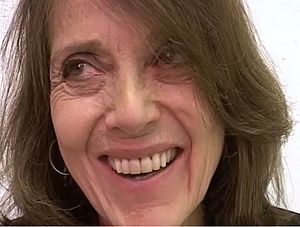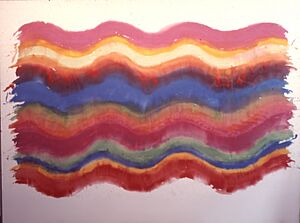Pat Lipsky facts for kids
Quick facts for kids
Pat Lipsky
|
|
|---|---|

Lipsky in April 2009
|
|
| Born | September 21, 1941 New York City, U.S.
|
| Education | Hunter College (MFA, 1968) Cornell University (BFA, 1963) |
| Known for | Painting, printmaking, writing |
| Movement | Lyrical Abstraction, Color Field Painting |
| Awards | 2008, 2001 Pollock-Krasner Foundation Grant 2001 American Academy and Institute of Arts and Letters Hassam Speicher Betts Purchase Prize 1999 Adolph and Esther Gottlieb Foundation Grant 1992 New York Foundation for the Arts |
Pat Lipsky is an American painter known for her colorful abstract art. Her work is often connected with two major art styles: Color Field painting and Lyrical Abstraction. These styles focus on using large areas of solid color.
Contents
Early Life and Education
Pat Lipsky grew up in New York City. Her mother was a painter and her father was an engineer. She loved art from a young age.
She went to Cornell University and earned a Bachelor of Fine Arts (BFA) degree in 1963. After that, she studied at Hunter College in Manhattan. There, she earned a Master of Fine Arts (MFA) degree in 1968. One of her teachers was the famous artist Tony Smith.
Career as a Painter

Lipsky had her first solo art show in New York at the André Emmerich Gallery. At the time, her art was part of a style called "Lyrical Abstraction." This style used bright, flowing colors that seemed to move across the canvas.
A good example of this is her 1969 painting Spiked Red. It has waves and bursts of bright, similar colors. The art critic Hilton Kramer wrote in The New York Times that her art connected to past styles while also looking to the future. He called her a "bold pictorial intelligence," meaning she was a very smart and creative painter.
The Lyrical Abstraction Movement
From 1970 to 1971, Lipsky's work was part of a famous art show called the Lyrical Abstraction exhibition. The show traveled across the United States and ended at the Whitney Museum in New York.
One critic said her paintings celebrated the "sheer splendor of color." He described the shapes in her art as licking out like flames. He found her paintings beautiful and exciting.
New Styles in the 1980s and 1990s
In the 1970s and 1980s, Lipsky's art began to change. She started using bolder colors and more geometric shapes, like squares and rectangles.
During the 1990s, she created a series of works called "The Black Paintings." These paintings used a much darker range of colors. A critic described them as "dramatic" and "powerful." Another writer said these paintings had a sense of "vertigo," making viewers feel a little dizzy and emotional.
Art in the 21st Century
In the 2000s, Lipsky's style changed again. She began to focus on single, bold images and bright colors. She often painted the same image in a series, but used different colors each time.
Art critics compared these paintings to music, especially the complex music of Bach. They also saw connections to other famous abstract artists like Frank Stella and Ad Reinhardt. One critic, Stephen Westfall, wrote in Art in America that these were her "most successful" paintings.
In 2016, a collection of her early paintings from the 1970s was found. They had been stored away for almost 50 years. Eleven of these paintings were shown in a New York gallery. The art critic Carter Ratcliff wrote that Lipsky was a leader of her generation of painters.
Today, Lipsky is represented by the James Fuentes Gallery.
Art Collections
Lipsky's paintings are very respected. They are part of more than 25 public art collections around the world.
Some of the famous museums that own her work include:
- The Whitney Museum
- The Smithsonian's Hirshhorn Museum
- The San Francisco Museum of Modern Art
- The Walker Art Center
- The Brooklyn Museum of Art
- Harvard's Fogg Art Museum
Influences and Ideas
Lipsky has been inspired by many different things, not just other painters. She said that reading books, looking at art from many different time periods, and listening to music have all shaped her work.
She believes that small details matter. For example, a musician choosing one note over another can change a whole song. In the same way, an artist choosing one color over another can change a whole painting.
She has also been influenced by famous abstract artists like Mark Rothko and Jackson Pollock, as well as her teacher, Tony Smith.
Writing and Honors
Besides painting, Lipsky is also a writer. Her essays about art have appeared in magazines like Tablet and The New Criterion. In 2025, her memoir, Brightening Glance, was published. It tells the story of her life as a painter.
Lipsky has received many awards for her art, including:
- Grants from the Pollock-Krasner Foundation (2001, 2008)
- A prize from the American Academy and Institute of Arts and Letters (2001)
- A grant from the Adolph and Esther Gottlieb Foundation (1999)
- Awards from the New York Foundation for the Arts (1992, 1996, 1998)


